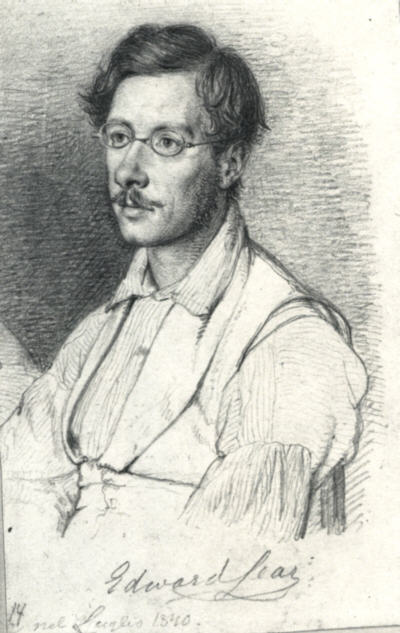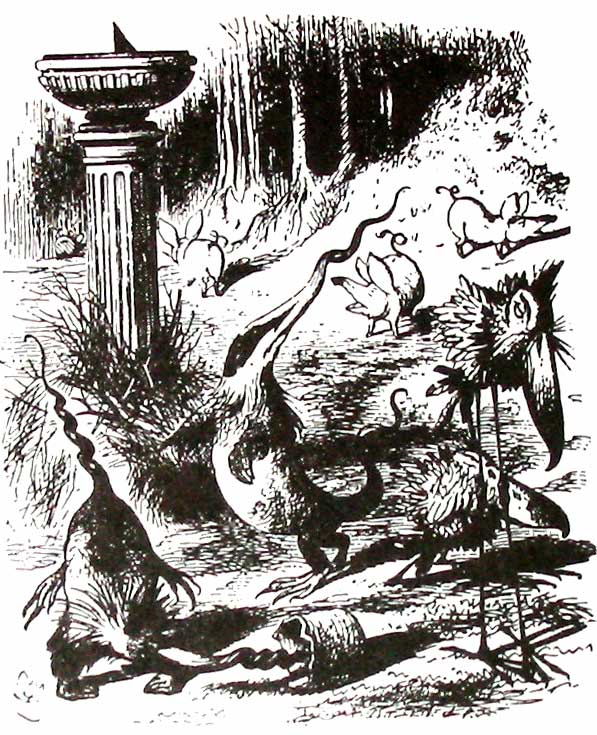|
The Scroobious Pip
"The Scroobious Pip" is a nonsense verse poem left unfinished by Edward Lear at the time of his death in 1888. Premise The poem tells of a fanciful animal of unknown taxonomy known only as "the Scroobious Pip" and the fruitless attempts of the other animals of the world to classify it. History In 1872, Lear began work on "The Scroobious Pip", but it was unfinished by the time of his death. In 1935, the poem, which had not been previously published, was released as a collectors' edition, of which 950 copies were printed. In 1968, the poem was completed by American poet Ogden Nash, who had been asked to finish the work. His contributions were accompanied by illustrations by Nancy Ekholm Burkert and printed together in a large elephant folio format. Harvard University Press published ''Teapots And Quails'', a small book of Lear's poetry that includes "The Scroobious Pip". Influence and legacy The poem's title was adopted as the stage name of a UK hip hop performance artist, ... [...More Info...] [...Related Items...] OR: [Wikipedia] [Google] [Baidu] |
Scroobius Pip
David Peter Meads (born 3 August 1981), known professionally and personally as Scroobius Pip (Dave), is an English actor and podcaster as well as a former spoken word poet and hip hop recording artist from Stanford-le-Hope, Essex. He first gained prominence as one half of hip hop duo Dan le Sac Vs Scroobius Pip sparked by their debut single " Thou Shalt Always Kill". He manages his own record label, Speech Development Records. He hosted the award-winning weekly radio show ''The Beatdown'' on XFM in the late 2000s and currently hosts the ''Distraction Pieces Podcast''. In August 2016, he released a book entitled ''Distraction Pieces''. He appears as French Bill, an assistant to Atticus, in the eight-part historical fiction series ''Taboo'' (2017) on BBC One and FX. Early career As a teenager, Scroobius Pip was inspired by punk music to buy a guitar and form various bands with his friends. His musical tastes quickly grew to encompass genres including hip hop and jazz an ... [...More Info...] [...Related Items...] OR: [Wikipedia] [Google] [Baidu] |
Nonsense Verse
Nonsense verse is a form of nonsense literature usually employing strong prosodic elements like rhythm and rhyme. It is often whimsical and humorous in tone and employs some of the techniques of nonsense literature. Limericks are probably the best known form of nonsense verse, although they tend nowadays to be used for straightforward humour, rather than having a nonsensical effect. Among writers in English noted for nonsense verse are Edward Lear, Lewis Carroll, Mervyn Peake, Edward Gorey, Colin West, Dr. Seuss, and Spike Milligan. The Martian Poets and Ivor Cutler are considered by some to be in the nonsense tradition. Variants In some cases, the humor of nonsense verse relies on the incompatibility of phrases which make grammatical sense but semantic nonsense – at least in certain interpretations – as in the traditional: Compare . Other nonsense verse makes use of nonsense words—words without a clear meaning or any meaning at all. Lewis Carroll and Edward Lear ... [...More Info...] [...Related Items...] OR: [Wikipedia] [Google] [Baidu] |
Poem
Poetry (derived from the Greek ''poiesis'', "making"), also called verse, is a form of literature that uses aesthetic and often rhythmic qualities of language − such as phonaesthetics, sound symbolism, and metre − to evoke meanings in addition to, or in place of, a prosaic ostensible meaning. A poem is a literary composition, written by a poet, using this principle. Poetry has a long and varied history, evolving differentially across the globe. It dates back at least to prehistoric times with hunting poetry in Africa and to panegyric and elegiac court poetry of the empires of the Nile, Niger, and Volta River valleys. Some of the earliest written poetry in Africa occurs among the Pyramid Texts written during the 25th century BCE. The earliest surviving Western Asian epic poetry, the ''Epic of Gilgamesh'', was written in Sumerian. Early poems in the Eurasian continent evolved from folk songs such as the Chinese ''Shijing'', as well as religious hymns (the Sanskrit ' ... [...More Info...] [...Related Items...] OR: [Wikipedia] [Google] [Baidu] |
Edward Lear
Edward Lear (12 May 1812 – 29 January 1888) was an English artist, illustrator, musician, author and poet, who is known mostly for his literary nonsense in poetry and prose and especially his limerick (poetry), limericks, a form he popularised. His principal areas of work as an artist were threefold: as a draughtsman employed to make illustrations of birds and animals; making coloured drawings during his journeys, which he reworked later, sometimes as plates for his travel books; and as a (minor) illustrator of Alfred, Lord Tennyson's poems. As an author, he is known principally for his popular nonsense collections of poems, songs, short stories, botanical drawings, recipes and alphabets. He also composed and published twelve musical settings of Tennyson's poetry. Biography Early years Lear was born into a middle-class family at Holloway, London, Holloway, North London, the penultimate of 21 children (and youngest to survive) of Ann Clark Skerrett and Jeremiah Lear, a stoc ... [...More Info...] [...Related Items...] OR: [Wikipedia] [Google] [Baidu] |
Taxonomy (biology)
In biology, taxonomy () is the scientific study of naming, defining ( circumscribing) and classifying groups of biological organisms based on shared characteristics. Organisms are grouped into taxa (singular: taxon) and these groups are given a taxonomic rank; groups of a given rank can be aggregated to form a more inclusive group of higher rank, thus creating a taxonomic hierarchy. The principal ranks in modern use are domain, kingdom, phylum (''division'' is sometimes used in botany in place of ''phylum''), class, order, family, genus, and species. The Swedish botanist Carl Linnaeus is regarded as the founder of the current system of taxonomy, as he developed a ranked system known as Linnaean taxonomy for categorizing organisms and binomial nomenclature for naming organisms. With advances in the theory, data and analytical technology of biological systematics, the Linnaean system has transformed into a system of modern biological classification intended to reflect the evolu ... [...More Info...] [...Related Items...] OR: [Wikipedia] [Google] [Baidu] |
Ogden Nash
Frederic Ogden Nash (August 19, 1902 – May 19, 1971) was an American poet well known for his light verse, of which he wrote over 500 pieces. With his unconventional rhyming schemes, he was declared by ''The New York Times'' the country's best-known producer of humorous poetry. Early life Nash was born in Rye, New York, the son of Mattie (Chenault) and Edmund Strudwick Nash. His father owned and operated an import–export company, and because of business obligations, the family often relocated. Nash was descended from Abner Nash, an early governor of North Carolina. The city of Nashville, Tennessee, was named after Abner's brother, Francis, a Revolutionary War general. Throughout his life, Nash loved to rhyme. "I think in terms of rhyme, and have since I was six years old," he stated in a 1958 news interview. He had a fondness for crafting his own words whenever rhyming words did not exist but admitted that crafting rhymes was not always the easiest task. His family lived ... [...More Info...] [...Related Items...] OR: [Wikipedia] [Google] [Baidu] |
Nancy Ekholm Burkert
Nancy Ekholm Burkert (born February 16, 1933) is an American artist and illustrator. Her most celebrated work is the picture book ''Snow White and the Seven Dwarfs'' (1972), which was a ''New York Times'' Notable Book and a Caldecott Honor Book (one runner-up for the Caldecott Medal). Biography Burkert was born in Sterling, Colorado, and moved with her family to Wisconsin in 1945. She received both her bachelor's and master's degrees from the University of Wisconsin, Madison. Burkert's first illustration work was for ''James and the Giant Peach'' in 1961. In 1982, she was co-author of a museum catalog for the Milwaukee Art Museum, on the Wisconsin artist John Wilde. She won the Boston Globe-Horn Book Special Award for ''Valentine and Orson'' in 1990. In 2003, she was subject of an exhibition at the Eric Carle Museum of Picture Book Art in Amherst. Work Her early work demonstrated a command of shading and texture through pencil and charcoal, in addition to her usual me ... [...More Info...] [...Related Items...] OR: [Wikipedia] [Google] [Baidu] |
Elephant Folio
Paper size standards govern the size of sheets of paper used as writing paper, stationery, cards, and for some printed documents. The ISO 216 standard, which includes the commonly used A4 size, is the international standard for paper size. It is used across the world except in North America and parts of Central and South America, where North American paper sizes such as "Letter" and "Legal" are used. The international standard for envelopes is the C series of ISO 269. International paper sizes The international paper size standard is ISO 216. It is based on the German DIN 476 standard for paper sizes. ISO paper sizes are all based on a single aspect ratio of the square root of 2, or approximately 1:1.41421. There are different series, as well as several extensions. The following international paper sizes are included in Cascading Style Sheets (CSS): ''A3'', ''A4'', ''A5'', ''B4'', ''B5''. A series There are 11 sizes in the A series, designated A0–A10, all ... [...More Info...] [...Related Items...] OR: [Wikipedia] [Google] [Baidu] |
Performance Artist
Performance art is an artwork or art exhibition created through actions executed by the artist or other participants. It may be witnessed live or through documentation, spontaneously developed or written, and is traditionally presented to a public in a fine art context in an interdisciplinary mode. Also known as ''artistic action'', it has been developed through the years as a genre of its own in which art is presented live. It had an important and fundamental role in 20th century avant-garde art. It involves four basic elements: time, space, body, and presence of the artist, and the relation between the creator and the public. The actions, generally developed in art galleries and museums, can take place in the street, any kind of setting or space and during any time period. Its goal is to generate a reaction, sometimes with the support of improvisation and a sense of aesthetics. The themes are commonly linked to life experiences of the artist themselves, or the need of denunci ... [...More Info...] [...Related Items...] OR: [Wikipedia] [Google] [Baidu] |
Literary Nonsense
Literary nonsense (or nonsense literature) is a broad categorization of literature that balances elements that make sense with some that do not, with the effect of subverting language conventions or logical reasoning. Even though the most well-known form of literary nonsense is nonsense verse, the genre is present in many forms of literature. The effect of nonsense is often caused by an excess of meaning, rather than a lack of it. Its humor is derived from its nonsensical nature, rather than wit or the "joke" of a punchline. History Literary nonsense, as recognized since the nineteenth century, comes from a combination of two broad artistic sources. The first and older source is the oral folk tradition, including games, songs, dramas, and rhymes, such as the nursery rhyme ''Hey Diddle Diddle''. The literary figure Mother Goose represents common incarnations of this style of writing. The second, newer source of literary nonsense is in the intellectual absurdities of court p ... [...More Info...] [...Related Items...] OR: [Wikipedia] [Google] [Baidu] |
.jpg)





